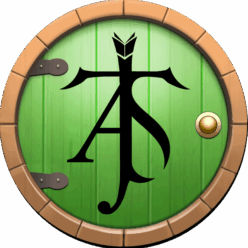TO GO TO THE ITALIAN VERSION OF THI ARTICLE
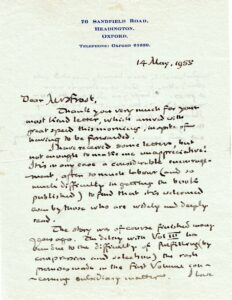 A letter from J.R.R. Tolkien (TCG Letter #2239) it is now for sale until January 8 through the American auction house RR Auction. This time, however, there is a hint of mystery, fortunately solved. The letter dates back to 1955, precisely the year when The Lord of the Rings was published. More specifically, when The Return of the King was released, though with significant delays. The first two volumes, The Fellowship of the Ring and The Two Towers, had been published on July 29 and November 11, 1954, respectively. Finally, the third and last volume was released in the United Kingdom almost a year later, on October 20, 1955. Five months before that date, on May 14, 1955, Tolkien wrote the letter to inform one of his readers that the third book was soon to be published. According to most experts, the recipient of the letter was “a certain Mrs. Frost”. Well, we can now reveal who actually received that letter!
A letter from J.R.R. Tolkien (TCG Letter #2239) it is now for sale until January 8 through the American auction house RR Auction. This time, however, there is a hint of mystery, fortunately solved. The letter dates back to 1955, precisely the year when The Lord of the Rings was published. More specifically, when The Return of the King was released, though with significant delays. The first two volumes, The Fellowship of the Ring and The Two Towers, had been published on July 29 and November 11, 1954, respectively. Finally, the third and last volume was released in the United Kingdom almost a year later, on October 20, 1955. Five months before that date, on May 14, 1955, Tolkien wrote the letter to inform one of his readers that the third book was soon to be published. According to most experts, the recipient of the letter was “a certain Mrs. Frost”. Well, we can now reveal who actually received that letter!
Tolkien’s Letter
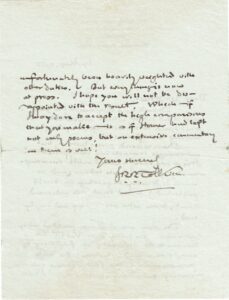 From his study in the Tudor-style house on Sandfield Road, in Oxford, Tolkien, on May 14, 1955, responded to a letter sent by a certain Mrs. Frost from Ravello, Italy, who had praised the first two volumes of The Lord of the Rings. The delay in the publication of The Return of the King was caused by the author himself, who struggled to complete the work. Tolkien wrote: “I have received some letters, but not enough to make me unappreciative! It is in any case a considerable encouragement, after so much labour (and so much difficulty in getting the book published) to find that it is welcomed even by those who are widely and deeply read”.
From his study in the Tudor-style house on Sandfield Road, in Oxford, Tolkien, on May 14, 1955, responded to a letter sent by a certain Mrs. Frost from Ravello, Italy, who had praised the first two volumes of The Lord of the Rings. The delay in the publication of The Return of the King was caused by the author himself, who struggled to complete the work. Tolkien wrote: “I have received some letters, but not enough to make me unappreciative! It is in any case a considerable encouragement, after so much labour (and so much difficulty in getting the book published) to find that it is welcomed even by those who are widely and deeply read”.
He then continued, reassuring the reader: “The story was of course finished many years ago. The delay with Vol. III has been due to the difficulty of fulfilling (by compression and selection) the rash promises made in the First Volume concerning subsidiary matter. I have unfortunately been heavily weighted with other duties.
But everything is now at press. I hope you will not be disappointed with the result. Which—if I may dare to accept the high comparisons that you make—is as if Homer had left not only poems, but an extensive commentary on them as well!”. Therefore, as we know from Tolkien’s letters to his publisher, the delay was due to his revisions of the ending and the preparation of Appendices, maps, and indexes (the “supplementary matters” mentioned here), parts of which ultimately had to be omitted due to space constraints. But who was the author writing to?
The Honorable Baroness of the Amalfi Coast
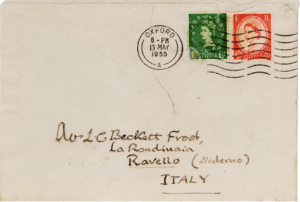 The letter is in excellent conditions and is not included in any of the published collections of the author’s correspondence, not even in the Revised and Expanded Volume with 150 additional letters released in November 2023. It is a handwritten letter, featuring Tolkien’s characteristic fluid handwriting and signed in full. The letter had already gone up for sale in June 2024 for nearly £13,000 (over €15,000). Now it is back on the market until January 8, with an estimated price of €15,000. The letter consists of a single sheet written on both sides and is accompanied by the original postal envelope, addressed to the devoted reader and also handwritten by Tolkien himself. It is precisely thanks to the envelope’s heading that we can better identify “Mrs. Frost of Ravello, Italy”, who greatly appreciated the first two volumes of The Lord of the Rings. The full and exact address is as follows: “Mrs L. C. Beckett Frost, La Rondinaia, Ravello (Salerno) Italy”.
The letter is in excellent conditions and is not included in any of the published collections of the author’s correspondence, not even in the Revised and Expanded Volume with 150 additional letters released in November 2023. It is a handwritten letter, featuring Tolkien’s characteristic fluid handwriting and signed in full. The letter had already gone up for sale in June 2024 for nearly £13,000 (over €15,000). Now it is back on the market until January 8, with an estimated price of €15,000. The letter consists of a single sheet written on both sides and is accompanied by the original postal envelope, addressed to the devoted reader and also handwritten by Tolkien himself. It is precisely thanks to the envelope’s heading that we can better identify “Mrs. Frost of Ravello, Italy”, who greatly appreciated the first two volumes of The Lord of the Rings. The full and exact address is as follows: “Mrs L. C. Beckett Frost, La Rondinaia, Ravello (Salerno) Italy”.
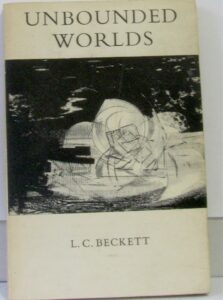 The letter was addressed to Lucille Catherine Beckett, married Frost (1884–1979). She was the second daughter of Lord Grimthorpe, Ernest William Beckett, making her a baroness, and she was also an English philosopher and scientist. Her most notable works include Unbounded Worlds (1959) and Neti Neti (1955), as well as Everyman and the Infinite (1922), The World Breath (1935), Movement and Emptiness (1968), and Insight and Solitude (1973). However, what stands out is the address itself, which lacks precise street or house number information. The letter had to reach its destination without further details because the location was well-known: Villa Rondinaia in Ravello.
The letter was addressed to Lucille Catherine Beckett, married Frost (1884–1979). She was the second daughter of Lord Grimthorpe, Ernest William Beckett, making her a baroness, and she was also an English philosopher and scientist. Her most notable works include Unbounded Worlds (1959) and Neti Neti (1955), as well as Everyman and the Infinite (1922), The World Breath (1935), Movement and Emptiness (1968), and Insight and Solitude (1973). However, what stands out is the address itself, which lacks precise street or house number information. The letter had to reach its destination without further details because the location was well-known: Villa Rondinaia in Ravello.
Lucille Catherine Beckett owned Villa Cimbrone, of which La Rondinaia was a part at the time, built exclusively for her. The villa is a small and precious gem, deserving a brief digression. Long abandoned, the entire property had been acquired in 1904 by her father. Ernest William Beckett, a nobleman and banker, visited the villa during his travels in Italy and fell in love with it. He embarked on an ambitious renovation project, which included the construction of battlements, terraces, and cloisters in a blend of faux-Gothic, Moorish, and Venetian architectural styles. The gardens, which stretched along the rocky cliff, were similarly redesigned, blending the wild English botanical style with the formal Italian style. Beckett died in London in 1917, and his body was brought to Villa Cimbrone to be buried at the foot of the Temple of Bacchus in the gardens.
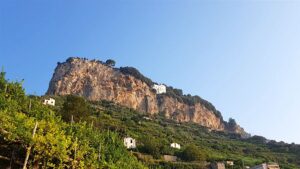 During World War I, Lucille Beckett worked first for the British ambassador in Rome and later for the American Red Cross. After divorcing Count Czernin (Czernin von und zu Chudenitz, the Austro-Hungarian Empire’s ambassador to the Holy See during the war), she decided to remain in Italy, living in Villa Cimbrone, which she had inherited from her father. Around 1930, she had La Rondinaia built and began living there. The villa has six floors and a total area of 600 square meters, while the surrounding garden spans 4 hectares. It is called “La Rondinaia” (The Swallow’s Nest) because it closely resembles a swallow’s nest, perched on a rocky peak shared with the park and Villa Cimbrone. While Villa Cimbrone is preceded by a long road leading to its scenic viewpoint, La Rondinaia is the opposite: the villa itself is built on a protruding rock.
During World War I, Lucille Beckett worked first for the British ambassador in Rome and later for the American Red Cross. After divorcing Count Czernin (Czernin von und zu Chudenitz, the Austro-Hungarian Empire’s ambassador to the Holy See during the war), she decided to remain in Italy, living in Villa Cimbrone, which she had inherited from her father. Around 1930, she had La Rondinaia built and began living there. The villa has six floors and a total area of 600 square meters, while the surrounding garden spans 4 hectares. It is called “La Rondinaia” (The Swallow’s Nest) because it closely resembles a swallow’s nest, perched on a rocky peak shared with the park and Villa Cimbrone. While Villa Cimbrone is preceded by a long road leading to its scenic viewpoint, La Rondinaia is the opposite: the villa itself is built on a protruding rock.
 As a result, the building, located at the far end of the park, enjoys a unique position, literally suspended over the sea, offering breathtaking views from its windows and terraces. La Rondinaia, accessible only on foot, overlooks the sea towards Positano and Capri. Surrounded by an extraordinarily beautiful park and embedded in the rocky cliff, constructing the villa was a feat of engineering, and its builders demonstrated remarkable bravery (the stories of daring workers suspended mid-air above the sea remain popular in the town). Today, the villa is a five-star hotel, while the garden is open to the public year-round for a fee.
As a result, the building, located at the far end of the park, enjoys a unique position, literally suspended over the sea, offering breathtaking views from its windows and terraces. La Rondinaia, accessible only on foot, overlooks the sea towards Positano and Capri. Surrounded by an extraordinarily beautiful park and embedded in the rocky cliff, constructing the villa was a feat of engineering, and its builders demonstrated remarkable bravery (the stories of daring workers suspended mid-air above the sea remain popular in the town). Today, the villa is a five-star hotel, while the garden is open to the public year-round for a fee.
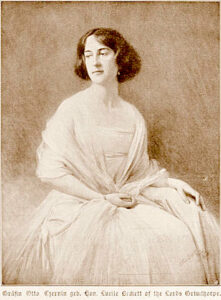 Lucille Beckett (pictured here on the right in an exclusive photo taken while she was still married to Count Czernin) was acquainted with some of the most prominent artists and scientists of her time. In Ravello, she hosted visitors such as E.M. Forster, D.H. Lawrence, and Greta Garbo. Vita Sackville-West and her husband Harold Nicolson also visited the Becketts, and it is said that Vita gave advice on the garden, although most of the couple’s gardening initiatives took place several years later (Sackville-West wrote a gardening column for The Observer from 1946 to 1961 and is remembered for the famous garden at Sissinghurst in Kent, which she created with her husband starting in 1930).
Lucille Beckett (pictured here on the right in an exclusive photo taken while she was still married to Count Czernin) was acquainted with some of the most prominent artists and scientists of her time. In Ravello, she hosted visitors such as E.M. Forster, D.H. Lawrence, and Greta Garbo. Vita Sackville-West and her husband Harold Nicolson also visited the Becketts, and it is said that Vita gave advice on the garden, although most of the couple’s gardening initiatives took place several years later (Sackville-West wrote a gardening column for The Observer from 1946 to 1961 and is remembered for the famous garden at Sissinghurst in Kent, which she created with her husband starting in 1930).
In 1926, Lucille Beckett married Captain Oliver Harry Frost, acquiring the honorary title of “Honorable” (used in Britain not only for Members of Parliament but also for the children of certain ranks of nobility), thus becoming the L. C. Beckett Frost mentioned in the letter. They later divorced in 1941. She had children only from her first marriage, including Jaromir Czernin, who was killed in an anti-fascist attack in Viterbo at the age of 15 in 1921, and the cultured Count Manfred Beckett Czernin, one of the top 20 aces of the Royal Air Force, famous for his role in the Battle of Britain and as a partisan leader who liberated Bergamo from the Nazis on April 28, 1945.
Lucille Beckett lived at La Rondinaia until 1972, when she sold the villa to the famous American writer Gore Vidal and moved to Cascais, Portugal, where she died on March 24, 1979 at the age of 94. Gore Vidal, who lived in the villa until 2005, wrote that Lucille Beckett’s spirit still permeated La Rondinaia.
SOURCES
– Mosley, Charles, editor. Burke’s Peerage, Baronetage & Knightage, 107th edition, 3 volumes. Wilmington, Delaware, U.S.A.: Burke’s Peerage (Genealogical Books) Ltd, 2003
– Michael Holroyd A Book of Secrets: Illegitimate Daughters, Absent Fathers. London: Chatto & Windus, 2010
